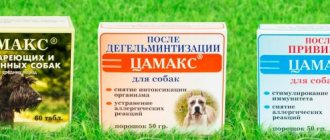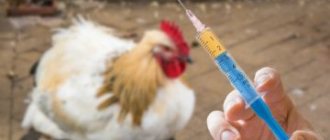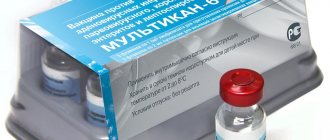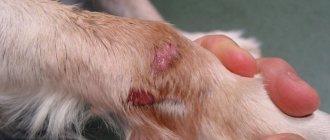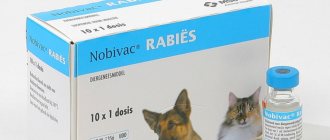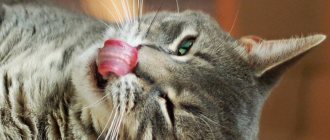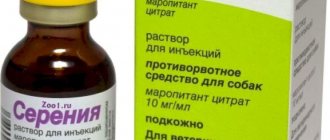The health of a pet depends not only on proper food. Parasites that carry infections and cause a lot of other problems constantly try to settle on an animal’s fur or inside its body. Fleas, helminths and ticks of a pet are a matter of concern for a caring person. Thanks to the modern drug Butox 50, you can solve the problem of getting rid of parasites and provide your pet with a healthy, comfortable life. The instructions for using it are very simple.
Composition and release form of the drug
The light yellow oil emulsion contains 5% synthetic pyrethroid deltamethrin. It dissolves well in water and has a slightly unpleasant odor. The emulsifying concentrate contains 50 g of deltamethrin.
The drug for dogs Butox is designed to combat fleas and ticks.
In pharmacies, Butox is sold in 1 ml ampoules.
Active ingredient and principle of action
Deltamethrin is used as the main active ingredient of Butox. This is a highly effective insecticide from the pyrethroid group used in agriculture. Like most isomers of this group, the action of deltamethrin is based on the activity of chrysanthemum acid, the free radicals in the formula are bromine atoms. In its technical form, deltamethrin is insoluble in water, so in the household it is used in ready-made form in Butox ampoules of 1 ml, the contents of which are diluted in 3-4 liters of water and used for treating premises and animals.
Method of penetration and absorption - contact and intestinal pesticide. Butox is used only for external use; recommended doses do not cause allergies. The substance is widely used in the agricultural sector, in households and in medicine to combat a number of parasites, harmful and synanthropic insect species. The deltamethrin formula contains only 1 isomer, which has a strong insecticidal effect. To create the drug, the one that has the most powerful insecticidal effect of the 8 existing isomers was chosen.
All pyrethroids have a destructive effect on the insect’s nervous system, disrupting calcium metabolism in synapses, and act on potassium-sodium channels, disrupting acetylcholine metabolism. As a result of strong stimulation of the nervous system, exoparasites die, and the protective effect of the active substance lasts about 15 days.
Analogue preparations of deltamethrin contained in Butox include butoflin, splender, decamethrin and others. The preparations are used for spraying agricultural crops and controlling pests. For warm-blooded representatives of the animal world, including humans, deltamethrin and Butox are moderately toxic substances. It is not used near apiaries; residues are not poured into open ground near water bodies due to the high toxicity of the isomers to fish.
Indications for use and effect of the drug
Butox is an insectoacaricidal agent that kills several types of parasites, including:
- Lice and fleas.
- Horseflies and lice eaters.
- Ixodid and scabies mites.
- Bugs and gnats.
- Flies and other ectoparasites.
The pyrethroid deltamethrin accumulates in the peripheral nerve ganglia of these parasites. Due to this, the insect’s neuromuscular impulses are blocked, and paralysis begins, leading to the inevitable death of the pest.
Pharmacology
Pyrethroids are able to interact with lipids of the skin, as well as plant leaves. The water and organic solvent evaporate and the waxy substance adheres to the fats. For warm-blooded creatures, pyrethroids are low-toxic because they are almost not absorbed, remaining on the surface of the skin. The second defense mechanism is the rapid destruction of the active substance to harmless compounds. Cold-blooded animals do not have defensive devices, so the pyrethroid, when it gets onto the surface of the body or into the intestines of the insect, deactivates acetylcholine. The functioning of the nervous system is disrupted, paralysis occurs, and the arthropod dies. When working with Butox 50 and other drugs containing pyrethroids, caution is required. Drops that fall on a flower plant will kill the bees, and if the drug spills on the soil and is then washed away by rain into the river, the fish will die.
Instructions for use
The drug is used externally in the form of an aqueous emulsion. The animal is bathed in water with the addition of Butox or sprayed.
In order not to harm the dog and yourself, you need to follow the rules for working with the drug:
- The mixture must be prepared immediately before use.
- It is forbidden to store the solution in its finished form, even for several hours.
- Weak and sick animals should not be treated.
- It is necessary to work with the drug wearing gloves and other protective equipment.
- The dog should not be allowed to lick its body after treatment. After waiting for the drug to dry, you need to put protective overalls on the animal.
Butox must be diluted in water before use.
Important. You cannot bathe the animal three days before treatment and three days after it!
Short-haired dog breeds can only be treated in problem areas. To do this, the solution with Butox must be applied to the desired area using a sponge.
Long-haired breeds are processed entirely. The most effective thing is to completely bathe the animal.
After applying the solution to the fur and skin, there is no need to rinse the animal. The drug must remain on the dog’s body in order not only to destroy existing parasites, but also to protect the pet in the future.
Application
The drug must be prepared directly on the day of its use, otherwise volatile substances will be removed from the emulsion, reducing the effectiveness of the product.
Butox is used for:
- bathing small livestock and poultry;
- spraying cattle;
- wetting lesions on animal skin;
- treatment of residential and domestic premises;
- spraying paddocks, stalls, poultry houses.
Let's consider the above points in more detail.
Frequency and dosage of use
According to the instructions for use, in the fight against lice eaters and fleas you will need a dose of Butox dissolved in 3-4 liters of water.
In the fight against ticks, Butox is used in a more concentrated form - 1 ml per 1.3 liters of water. The same solution is used for preventive purposes. It is used during peak pest activity, treating the animal every week.
Dog scabies are treated with 1 ml of emulsion diluted in 1 liter of water. The main thing is to follow the dosage and be sure to re-treat no later than after 10 days.
These dosages are given for the administration of a bathing solution.
If you decide to spray an animal, then you need to dissolve the appropriate amount of emulsion in a liter of water:
- For scabies – 1 ml per liter.
- For ticks – 0.7 ml per liter.
- For fleas – 0.4 ml per liter.
The concentration of Butox solution depends on the purpose for which it will be used.
You need to spray the animal starting from the head and moving towards the tail. Paws and tail should be treated at the very end of the procedure.
Butox does not irritate the skin and does not cause side effects if the drug is used according to the instructions.
General recommendations
Butox50 is a highly effective means of combating exoparasites and in some cases can have a sanitizing effect on a number of pathogens due to its pesticide action. When purchasing Butox 50 in ampoules, the instructions for it contain a detailed description of the procedure for treating your pet. It's not difficult, but it does require some precautions.
The key feature of Butox is its low price; as a rule, you can buy the product in veterinary pharmacies in the form of one ampoule. Its cost is significantly lower than other “pipette” drugs that are used for treatment, and its effectiveness is much higher.
Also for Butox 50, the instructions for use contain information on the treatment of tick-borne infestations in animals. Moreover, treating your pet will cost a minimal amount, the effectiveness will be very high, and the toxicity will be low.
Despite the fact that few pet owners know about this quality of Butox, it is a highly effective drug for a number of diseases. It is distinguished by low toxicity, price and high efficiency in the fight against a number of parasitoses in animals.
In some cases, subject to safety rules, it can be used to treat a person under the supervision of a doctor. For example, for complex scabies, mites infestation of the scalp. Treatment is carried out once every 7-10 days, without violating the dosage.
Premises treatment
In the fight against fleas and other pests, additional measures must be taken. Often you have to treat the entire apartment or room. Butox has also proven its effectiveness in this regard, since it allows you to get rid of not only animal parasites, but also ants, bedbugs, cockroaches and other living creatures.
On the shelves of veterinary pharmacies you can find a liter bottle of the drug that is used for these purposes.
The dosage for treating the room in this case will be different:
- 15 ml of product per liter of water to combat flying pests.
- 30 ml of product per liter of water to combat crawling pests.
Processing of farm animals
Spraying cows
Product dosage per 100 liters of water:
- for scabies - 100 ml;
- lice - 25 ml;
- flies, ticks - 50 ml.
Fill the spray container with the working solution (you can use a garden sprayer). One cow requires 3 liters of diluted drug.
Spray in sequence:
- head (ears, head);
- body (neck, withers, back, sacrum);
- area around the anus and tail;
- limbs.
If the animal is not feeling well (lethargic, there is a suspicion or conclusion of illness), it is better to delay treatment until the cow has completely recovered.
Avoid getting the emulsion into your eyes and nose. After treatment, prevent animals from licking the drug from the fur. Do not touch the fur of cows with your hands without gloves for three days. Also exclude slaughter.
Spraying rabbit ears
Dosage: 0.5 ml per 0.5 liter of water.
Take 0.5 ml of the drug into a three-cc syringe and dilute it in 1/2 liter of water in a spray bottle.
Spray the ears, avoiding contact with the eyes, nostrils, and mouth.
In 2 weeks the ears will be clean.
Sheep bathing
Product dosage per 100 liters of water:
- for scabies - 100 ml;
- lice - 25 ml;
- flies, ticks - 50 ml.
Bathing is carried out in warm weather, after shearing sheep, which ensures access of the drug to the animal’s skin. They use a bathtub, which is filled with water with butox dissolved in it. After bathing, it is not recommended to touch sheep with hands without gloves or immediately slaughter them.
Poultry processing
Dosage: 1 ml of butox per 1 liter of water.
It is more convenient for two people to bathe a bird:
- one serves;
- the second bathes and makes sure that the product does not get into the eyes.
Afterwards, the bird is taken out of the room. All litter and fluff is removed. Walls and floors are being processed. Then - mandatory ventilation.
Premises treatment
Most often, it is animals that cause the appearance of ectoparasites (fleas, ticks, lice).
Fleas prefer to settle throughout the entire area of the room, at a height of no more than 1 meter. The most favorite places of insects:
- carpets;
- rugs;
- baseboards;
- furniture;
- animal habitats.
Fleas can crawl into the most secluded place in a room.
Mix 1 ampoule of the drug with 4 liters of water and treat the room with a spray bottle or sprayer. Afterwards, ventilate for 2 hours. Repeat treatment after 10 days (taking into account the insect development cycle).
Safety precautions must be followed. Before working with the product, put on:
- gloves;
- respirator;
- protective glasses;
- robe or protective suit.
Poultry houses are treated by spraying walls, floors, ceilings, jambs and doors. Prepare a solution at the rate of 3 ml of butox per 1 liter of water.
Mites (downy pyroeaters), which parasitize birds, love to live in wooden flooring, doors and other wood trim.
Cautions for use
Since Butox is a very toxic drug, precautions should be taken when working with it:
- All work must be carried out away from food.
- Gloves must be worn.
- After work, you need to wash your hands with soap.
- Do not allow the drug to get into the animal’s nose, eyes or mouth.
When working with Butox, all precautions should be taken.
If the emulsion gets into your eyes or mucous membranes, you should immediately rinse them with water. If the drug was accidentally ingested, you must take 3 tablets of activated carbon or other absorbent.
Cautions
The instructions for the drug must be followed completely. Precautionary measures will allow you to avoid troubles when using Butox:
- handle the animal only with gloves;
- the product should not get into the animal’s nose, mouth or eyes;
- After abundant wetting, the fur must dry completely, you need to protect your pet from licking the fur at this time;
- Butox cannot be used in combination with organophosphate insecticides;
- if an animal exhibits hypersensitivity to the drug, its use should be stopped immediately;
- The drug is not used on damaged areas of the skin, on open wounds, or on weakened animals.
Advantages of the drug
The drug Butox is widely used not only due to its low price, but also due to its good effectiveness. If you follow the instructions for use, you can get rid of fleas in just one application. Although it is also possible to re-treat the animal after two weeks.
The main difference between Butox and its analogues is that the drug does not need to be dripped onto the skin, but rather the prepared emulsion must be applied to the fur all over the body.
The main advantages of Butox include the following:
- Low cost. The drug costs less than 100 rubles.
- Easy to use and prepare the solution.
- Residual protective effect.
- Availability of the drug in all veterinary pharmacies.
- High efficiency.
Composition of the drug
The active component of the drug is deltamethrin. It is a white, odorless powder with high insecticidal properties. Poorly soluble in water, but very soluble in oils, the drug is non-toxic in aqueous suspensions. Due to this feature of deltamethrin, it is used in tandem with an organic eluent. Thanks to this manipulation, the powder is better distributed in the preparation.
What exactly is Butox? This is a 5% solution of deltamethrin (that is why the drug is sometimes called Butox-50). The finished product smells like kerosene. Forms a stable emulsion with water.
Reviews about the drug from breeders
Dog owners note that Butox really protects their pets from parasites.
Irina, Khabarovsk. A dog appeared in our apartment recently, but we met Butox much earlier. Our apartment is on the first floor, so our guests every year were ants and all sorts of bugs that appear from dampness. Someone recommended Butox, which helped us quickly get rid of these parasites. And when we got an Alabai, we didn’t even think about how to get fleas out of him. The only inconvenient moment for us was that we had to completely bathe our pet and then wrap him up so that he would not lick his lips. Gradually, the Admiral got used to bathing and dressing, so we started using Butox as a preventive measure against ticks.
Marina, Suvorov. Butox was recommended to us by friends. There are quite a few pets living in our house, so the choice was precisely inexpensive products. Having purchased Butox, we treated all our cats and dogs with it, but were unpleasantly surprised by the smell. The unpleasant aroma seemed to permeate the animals through and through. But this was our first meeting with this product. When we resorted to using it again, we, strangely, did not smell it. It turned out that this was a matter of habit. For the second year now, Butox has always been on the shelf in our country house. Even though our animals are treated, they run around the street and “catch” parasites from other yard animals. The instructions say that the protective effect of the drug lasts up to 15 days. I can confidently confirm this from my own experience. Our Busyas and Basyas have enough protection for almost a month. Only after this period has expired do we have to carry out processing again.
Efficiency
The domestic drug is much more effective than the imported one. A foreign product works great outside our country or in the first year of its appearance on the Russian market. Subsequently, this drug begins to be diluted, which reduces its beneficial properties. For example, spraying dogs
Butox has long been the most effective means of combating external parasites in Russia. The cost of the drug in large containers (especially for farmers) is much cheaper than in ampoules. The only negative is that the protection against ectoparasites is short-lived. It is necessary to repeat the treatment after 10 days due to the development characteristics of insects.
Treatment of poultry housing areas
To get rid of blood-sucking parasites, it is extremely important to clean and disinfect the premises where birds are kept . You only need to work in protective clothing, paying special attention to respiratory protection.
The number of birds is removed from the chicken coop. Before processing, clean all feeders, boxes, perches, partitions and cages. The remaining food and bedding are taken out and burned, and the floor is swept.
The solution is mixed at the rate of 15-30 ml of Butox 50 per 10 liters of water. Per 100 sq. m requires 5-10 liters of solution depending on the type and porosity of surfaces .
The resulting emulsion is evenly sprayed on all areas of the chicken coop: walls, ceiling, floor, perches, cages and partitions. Joints, corners, crevices, fastenings and other hard-to-reach places are intensively processed.
After wet treatment, keep the room tightly closed for 3-4 hours, then ventilate well for several days. After ventilation is completed, new bedding is laid and the chickens are released. .
For prevention, chicken coops are cleaned and disinfected regularly, at least 1-2 times a year, regardless of the illness of the chickens. It is important to constantly ventilate the room and periodically change the bedding, preventing the creation of a humid environment for the spread of harmful microorganisms and insect larvae.
Advantages and disadvantages of “Butox-50”
Like all drugs, Butox-50 in ampoules has a number of disadvantages:
- presence of a strong unpleasant odor;
- age restrictions (the drug is not used to treat animals under six months);
- the result does not appear instantly, but a day after application.
Along with this, the product also has a number of advantages:
- high level of efficiency;
- low level of toxicity;
- Availability: “Butox-50”, the price of which is on average 100 rubles, can be purchased at any pharmacy.
Hazard class and safety measures
In accordance with GOST, “Butox” belongs to the third class of hazard, that is, to moderately dangerous substances that can cause an allergic reaction if the dosage is violated and poisoning if ingested, but do not pose the same danger to warm-blooded creatures as to insects
The following precautions must be observed when using this drug:
- Before using the product, you must carefully read the instructions for use.
- When using the product, you must wear protective clothing, which, among other things, includes safety glasses, a hat, a respiratory mask and disposable rubber gloves. It’s best to wear things that you won’t mind throwing away later.
- After completing the treatment, you must thoroughly wash all exposed areas of the body with soap.
- In case of contact with mucous membranes or inside the body, it is necessary to immediately rinse them with a significant volume of water. If these measures do not help and an allergic reaction occurs or any side effects occur, you should immediately seek emergency professional medical help.
- Empty Butox containers, as well as unused remains of the product, are subject to mandatory disinfection. This procedure is carried out by allowing soda ash to sit in a prepared solution for at least 6 hours, after which the container must be rinsed with clean water.
- The containers in which the product was located are not allowed to be further used for household or any other purposes, even if they have been thoroughly disinfected.
Compatibility
“Butox” has not been tested for compatibility with most other antiparasitic agents, so the combined use of several drugs at the same time is not recommended; moreover, the effectiveness of this insecticide is quite sufficient for the high-quality destruction of insects.
Considering the fact that it contains deltamethrin, Butox is definitely incompatible with the following elements:
- Oxidizing substances.
- Substances belonging to the halogen group.
- Insecticides based on organic phosphorus compounds.

